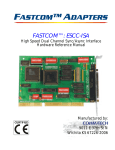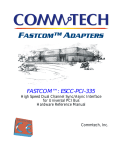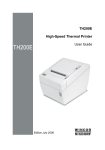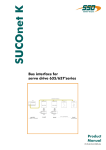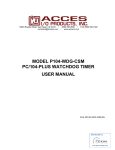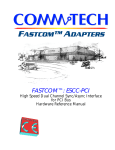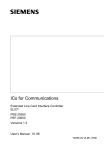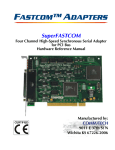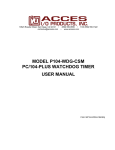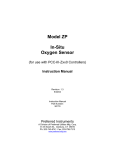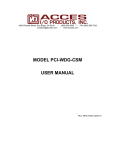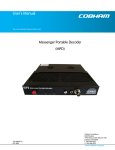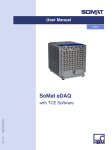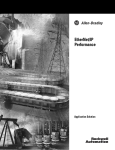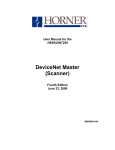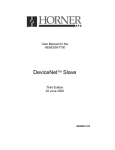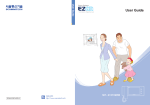Download FASTCOM™: ESCC-104-ET HARDWARE MANUAL
Transcript
FASTCOM™ ADAPTERS
FASTCOM™: ESCC-104-ET
High Speed Dual Channel Sync/Async
Extended Temperature Interface for PC/104 Bus
Hardware Reference Manual
Manufactured by:
http://www.commtech.com.cn/
COPYRIGHT (C) 2003
All rights reserved, including those to reproduce this document or parts thereof in
any form without permission in writing from Commtech, Inc.
FASTCOM and SMART14 are trademarks of Commtech, Inc.
IBM is a registered trademark of International Business Machines Corporation.
Microsoft is a registered trademark of Microsoft Corporation.
WINDOWS is a trademark of Microsoft Corporation.
REVISION NOTES
REVISION PAGE NUMBER
1.0
All
1.1
29
1.2
All
1.3
22
CHANGES MADE
Created document
Changed warranty period to lifetime
Fixed all references to non-ET board
Fixed BDF error
CONTENTS
INTRODUCTION........................................................................................................................ 1
SPECIFICATIONS ....................................................................................................................... 2
FEATURES ................................................................................................................................ 2
BOARD LAYOUT ........................................................................................................................ 3
40-PIN LATCH-LOCK HEADER DESCRIPTION ...................................................................... 4
PIN-OUT DESCRIPTION .............................................................................................................. 5
INSTALLATION ......................................................................................................................... 6
FACTORY SWITCH SETTINGS ...................................................................................................... 6
INSTALLING THE WINDOWS NT/2000 ESCC DRIVER ................................................................... 6
TESTING THE INSTALLATION ....................................................................................................... 9
FASTCOM: ESCC-104-ET WINDOWS NT/2000 TEST .............................................................. 9
FASTCOM: ESCC-104-ET WINDOWS 9X TEST ...................................................................... 11
SWITCH DESCRIPTIONS ....................................................................................................... 14
SWITCH 1, ADDRESS ............................................................................................................... 14
SWITCHES 2 AND 3, INTERRUPTS ............................................................................................. 15
INTERRUPT SHARING ............................................................................................................... 15
SWITCH 4, DMA CHANNEL SELECT .......................................................................................... 16
SWITCH 5, MODE #1 SWITCH................................................................................................... 17
SWITCH 6, MODE #2 SWITCH................................................................................................... 17
PROGRAMMING ..................................................................................................................... 18
RS-422 / RS-485 ...................................................................................................................... 19
TERMINATION RESISTANCE ...................................................................................................... 20
PROGRAMMABLE CLOCK GENERATOR (AMI FS6131-01)................................................ 21
FEATURES .............................................................................................................................. 21
DETERMINING AND SELECTING BAUD RATES ............................................................................. 21
MASTER CLOCK MODE ............................................................................................................ 22
AN IMPORTANT FACT ABOUT THE CLOCK GENERATOR ............................................................... 23
EXAMPLES AND EXPLANATIONS ................................................................................................ 23
CLOCKING CONCEPT BLOCK DIAGRAM ...................................................................................... 27
TECHNICAL SUPPORT .......................................................................................................... 28
APPENDIX A ........................................................................................................................... 29
FASTCOM: ESCC-104-ET REGISTER MAP ....................................................................... 29
APPENDIX B ........................................................................................................................... 31
I/O ADDRESS SETTINGS.................................................................................................... 31
APPENDIX C ........................................................................................................................... 37
SIEMENS SAF 82532 DATA SHEET ................................................................................... 37
1
INTRODUCTION
The new FASTCOM™: ESCC-104-ET is a very high-speed, dual channel, synchronous/asynchronous serial
communications adapter based upon the Siemens 82532 Enhanced Serial Communication Controller (ESCC).
The FASTCOM™: ESCC-104-ET is designed to support data rates up to 10 Mbits/second (maximum data rates
are affected by many factors, including computer performance, cable quality, and software overhead), and to
reduce the hardware and software overhead needed for serial communications. Each sync/async channel on the
FASTCOM™: ESCC-104-ET has its own DPLL encoder/decoder and programmable protocol support. In
addition, a built-in 64 byte FIFO provides the FASTCOM: ESCC-PCI with a very high throughput as well as
requiring less system CPU time than any other HDLC adapter. The FASTCOM™: ESCC-104-ET directly
supports HDLC, X.25 LAP B, ISDN LAP D, SDLC, ASYNC, and BISYNC protocols, and features a high speed
RS-422/RS-485 interface. HDLC features include choice of CRC polynomial (CRC-CCITT or CRC-32), expanded
line encoding methods (FM and Manchester), and preamble transmission.
Many engineers have avoided using synchronous communication adapters because of their programming
complexity. The FASTCOM™: ESCC-104-ET provides high-speed data communications to designers and
engineers, while greatly reducing development time and system complexity.
The FASTCOM: ESCC-104-ET is also available in a PCI bus version (FASTCOM: ESCC-PCI) and an ISA bus
version (FASTCOM: ESCC-ISA).
The following diagram illustrates the basic structure of the FASTCOM™: ESCC-104-ET:
PC/104
BUS
IRQ 2
|
|
|
IRQ 15
SWITCH 2,3
INTERRUPTS
DMA 1
DMA 3
DMA 5
DMA 7
SWITCH 4
DMA
SELECT
DATA
DATA
BUFFER
16
D0
|
|
|
D15
INTERRUPT
SHARING
LOGIC
A0-A5
INTERRUPT
DMA
RS-422/485
DRIVERS/RECEIVERS
COMMUNICATION
CONTROLLER
SWITCH 5,6
MODE
CONFIGURATION
82532
6
DMA
CONTROL
LOGIC
A0-A5
SWITCH 1
ADDRESS
ADDRESS
SELECT
A6
|
|
|
A13
CHANNEL 1 (OF 2)
SD+
SDRD+
RDRTS+
RTSCTS+
CTSDCD+
DCDDSR
DTR
RT+
RTST+
STTT+
TT-
2
SPECIFICATIONS
COMMUNICATION CONTROLLER:
SIEMENS 82532
DRIVERS/RECEIVERS:
RS-422/RS-485
CONNECTOR CONFIGURATION:
.100" X .100" Latch/Ejector Header
POWER REQUIREMENTS:
+5V @ 300mA (typical)
BUS INTERFACE:
PC/104
ENVIRONMENT:
Storage Temperature Range:
Operating Temperature Range:
Humidity:
-55 C to +125 C
-40 C to +85 C
0 to 90% (non-condensing)
FEATURES
High speed, up to 10Mbits/s (dependent upon system capabilities)
Much easier to program and use than other HDLC adapters
Supports HDLC, SDLC, ISDN LAP D, and X.25 LAP B, ASYNC, BISYNC
Uses extended temperature components
Designed for operation in more extreme environments
Drivers: RS-422/RS-485 multi-drop
Excellent noise rejection, cable lengths up to 4000 feet
Use low cost "twisted pair" cable
RS-485 mode
Up to 32 FASTCOM™: ESCC-104-ET adapters can share the same "twisted pair"
Driver control is automatic (via the RTS line)
Serial Interface:
Internal or External Clock Source
Asynchronous, Monosync/Bisync, and HDLC/SDLC data formatting
1X (isosynchronous) or 16X oversampling for Asynchronous format
Different modes of data encoding (NRZ, NRZI, FM0, FM1, Manchester)
CRC-CCITT or CRC-32 (for HDLC/SDLC modes)
CRC-CCITT or CRC-16 (for BISYNC mode)
Modem control lines (RTS, CTS, DTR, DCD, DSR)
Collision resolution
Programmable bit inversion
Transparent RD/SD of data bytes without HDLC framing
Protocol Support (HDLC/SDLC):
Types of protocol support: Automatic, Manual, and Transparent
Handling of bit-oriented functions in all modes
Handling of I and S frames in Auto mode
Modulo 8 and 128 operation
64 byte FIFOs per direction
Storage of up to 17 short received frames
3
BOARD LAYOUT
SEND/RECEIVE
STATUS LEDs
TERMINATION
RESISTORS
SAF82532
LATCH
LOCK
CONNECTOR
DMA CHANNEL
SELECT
MODE #1
BASE ADDRESS
MODE #2
IRQ LEVEL
PC/104
CONNECTORS
TERMINATION REFERENCE:
CHANNEL 1:
CHANNEL 2:
SIGNAL
RT
RD
CTS
ST
DCD
REF
R12
R13
R14
R15
R16
RT
RD
CTS
ST
DCD
R7
R8
R9
R10
R11
LED INDICATORS:
RED
GREEN
TRANSMIT ACTIVE
RECEIVE ACTIVE
RED
GREEN
TRANSMIT ACTIVE
RECEIVE ACTIVE
PACKING LIST:
FASTCOM: ESCC-104-ET CARD
FASTCOM CD
If an omission has been made, please call technical support for a replacement.
4
40-PIN LATCH-LOCK HEADER DESCRIPTION
The Fastcom: ESCC-104-ET comes with a 40-pin latch-lock header. This requires the use of a ribbon cable
rather than the DB-style shielded cable normally supplied. Following is the pin-out description of the 2x20 header.
POLARIZING
KEY
LATCH
39 37 35 33 31 29 27 25 23 21 19 17 15 13 11
9
7
5
3
1
40 38 36 34 32 30 28 26 24 22 20 18 16 14 12 10
8
6
4
2
PIN #
SIGNAL
PIN #
SIGNAL
1
GND
21
1ST-
2
2RT+
22
1DCD+
3
2RT-
23
1DCD-
4
2DSR
24
2SD+
5
1RT-
25
2SD-
6
1RT+
26
2RTS+
7
1DSR
27
2RTS-
8
2RD+
28
2TT+
9
2RD-
29
2TT-
10
2CTS+
30
2DTR
11
2CTS-
31
1SD-
12
2ST+
32
1SD+
13
2ST-
33
1RTS-
14
2DCD+
34
1RTS+
15
2DCD-
35
1TT-
16
1RD+
36
1TT+
17
1RD-
37
1DTR
18
1CTS+
38
N/C
19
1CTS-
39
N/C
20
1ST+
40
GND
LATCH
5
PIN-OUT DESCRIPTION
Signal Pin Descriptions
Channel 1
Channel 2
Pin Number Pin Number Name Pin Description 422 Circuit
1
1
GND
Ground
AA
40
40
GND
Ground
AB
31
25
SDTransmit Data
BA
32
24
SD+
Transmit Data
BA
17
9
RDReceive Data
BB
16
8
RD+
Receive Data
BB
33
27
RTS- Request to Send
CA
34
26
RTS+ Request to Send
CA
19
11
CTSClear to Send
CB
18
10
CTS+
Clear to Send
CB
7
4
DSR
DCE Ready
CC
37
30
DTR
DTE Ready
CD
Clock Signal Pin Descriptions
Channel 1
Channel 2
Pin Number Pin Number
23
15
22
14
35
29
36
28
5
3
6
2
21
13
20
12
Name
DCDDCD+
TTTT+
RTRT+
STST+
Pin Description
422 Circuit
Data Carrier Detect
CF
Data Carrier Detect
CF
Transmit Clock Out
DA
Transmit Clock Out
DA
Receive Clock In
DD
Receive Clock In
DD
Transmit Clock In
DB
Transmit Clock In
DB
NOTE: The DTR and DSR signals are single-ended (unbalanced)
6
INSTALLATION
Important: Observe Electrostatic Discharge (ESD) precautions when handling the FASTCOM™: ESCC-104-ET
board.
•
Unpack the FASTCOM™: ESCC-104-ET. Keep the box and static bag for warranty repair returns.
•
Check the switches to be sure that they are set as illustrated below (Factory Switch Settings).
FACTORY SWITCH SETTINGS
ON
ADDRESS SELECT (SW1) - 280H
1 2
ON
3 4
5
6 7
8
6 7
8
6 7
8
6 7
8
6 7
8
ON
IRQ SELECT (SW2 & SW3) - 5
1 2
3 4
1 2
3 4
5
ON
DMA SELECT (SW4) - NO DMA
1 2
3 4
5
ON
MODE #1 CONFIG (SW5) - RS-422, DMA DISABLED, TXCLK IS OUTPUT
1 2
3 4
5
ON
MODE #2 CONFIG (SW6) - NO LOOPBACK (485) CTS DISABLED
MODE #2 CONFIG (SW6) - 422 CLOCK MODE
1 2
3 4
5
INSTALLING THE WINDOWS NT/2000 ESCC DRIVER
The NT/2000 driver for the ESCC is the ESCCDRV.SYS file. It is a kernel mode driver. The NTINSTALL.EXE
program is intended to simplify the process of adding registry information about the base address, interrupt, and
DMA information about each channel.
INSTALL DRIVER: Pressing this button will copy the ESCCDRV.SYS file to your C:\winnt\system32\drivers
subdirectory. It will create the following subkey in the registry:
HKEY_LOCAL_MACHINE\SYSTEM\CurrentControlSet\Services\esccdrv
In that key it adds the following information:
DisplayName: REG_SZ:esccdrv
ErrorControl: REG_DWORD:0x01
ImagePath: REG_EXPAND_SZ:\??\C:\WINNT\System32\Drivers\esccdrv.sys
Start: REG_DWORD: 0x02
Type: REG_DWORD: 0x01
•
These values are actually created by the CreateService API call.
7
•
The C:\WINNT part of the image path will (should) reflect your installed system directory (i.e., the
system drive and where your Windows files are installed), and could be different depending on how
you originally installed Windows.
•
The Start parameter is set to automatic. This will load and run the driver every time that Windows is
started. If you want to start and stop it manually, you can change the start type by using the Control
Panel -> Devices -> Startup button after the driver is installed.
•
The Type parameter is kernel mode.
ADD BOARD: Pressing this button will add the information to the registry about where a particular ESCC
channel is located. It will create a subkey under the esccdrv\parameters such as esccdrv\parameters\ESCC0.
The dialog that appears when you press ADD BOARD needs to have the Base Address, Interrupt, and DMA
information for the card you are installing. For example, if you use the factory defaults (do not change any of the
switch settings), you would press the ADD BOARD button two times. The first time you would enter:
Base = 0x280
IRQ = 5
DMAR = 0
DMAT = 0
Channel = 0
The second time you would enter:
Base = 0x280
IRQ = 5
DMAR = 0
DMAT = 0
Channel = 1
This will create two subkeys esccdrv\parameters\ESCC0 and esccdrv\Parameters\ESCC1. The value that you
enter for Base should match setting of the base address switch on the board. The value that you enter for IRQ
should match the setting of the IRQ LEVEL switch on the board.
The value(s) that you enter for DMAR and DMAT will determine if the driver uses DMA or not. If they are both
zero, then DMA is not used (interrupt only mode).
If they are both nonzero and not equal (i.e.,
DMAR!=DMAT!=0), then DMA mode is used.
The example program is compiled assuming that DMA is not used (i.e., DMAR=DMAT=0). Specifically, the DMA
bit in the XBCH register of the 82532 is clear, indicating that the 82532 should operate in “interrupt only” mode.
You can manually add/delete these registry entries if you wish. But earlier version(s) of the driver will crash if you
do not define any boards and start/stop/start the driver.
You can manually add a value in the esccdrv\parameters\ESCCx subkey:
Buffers:REG_DWORD: 0xYY
This controls the number of receive buffers (frames) that the driver will allocate and use. The default value is 10
(0x0a) and can be any value from 2 to 100.
REMOVE BOARD: Pressing this button will delete the subkey (and its values) for the selected board (channel).
START: Pressing this button will load the driver. It is equivalent to using Control Panel -> Devices -> Start with
the esccdrv selected.
STOP: Pressing this button will stop/unload the driver. It is equivalent to using Control Panel -> Devices -> Stop
8
with the esccdrv selected.
REMOVE DRIVER: Pressing this button will attempt to stop the driver (if it is started) and will delete the esccdrv
subkey and all of its subkeys. It will not delete the esccdrv.sys file from your winnt\system32\drivers directory. If
you want to completely remove the driver you must delete this file manually.
The intended sequence of events is:
Press Install Driver button
Press Add Board button (2 times per board installed)
Fill in address/irq/dma information
Press Start Esccdrv button
Press OK/Exit
If you want to change/add a board later, you would need to follow the following sequence:
Press Stop Esccdrv button
Press Add Board/Remove Board as necessary
Press Start Esccdrv button
Press OK/Exit.
If you do not have any boards (channels) installed and press the start button, you must manually delete the
esccdrv.sys and the esccdrv subkey before rebooting or any attempt to stop the driver could cause Windows to
go into its "bug check" mode (Blue Screen of Death).
The NTINSTALL.EXE program does not do any checking on the values that you enter. If you enter unreasonable
values for address/irq/dma, there is a very good chance that Windows will become unstable ("bug check" mode).
The driver only looks at the registry information on startup. If you add boards while the driver is running, the new
devices will not exist until the system is restarted or you stop and restart the driver. For example if you:
Press Install Driver,
Press Add Board (enter channel 0 info),
Press Add Board (enter channel 1 info),
Press Start Esccdrv,
Press Add Board (enter channel 0 info),
Press Add Board (enter channel 1 info),
Run example program (esccmfc),
The only devices that would be available would be ESCC0 and ESCC1. If you try to open ESCC2 or ESCC3, you
will get a “can’t get a handle” message. To use ESCC2 or ESCC3, you must press the STOP ESCCDRV button,
and then press the START ESCCDRV button (or reboot) to allow the driver to recognize the additional board.
9
TESTING THE INSTALLATION
To fully test the installation of your FASTCOM™: ESCC-104-ET, you will need to build two "loop back” plugs.
Materials needed are two 40 pin female receptacles, 24 pins, and 12 short pieces of 20 or 24 AWG stranded wire.
Jumper the pins together on the 40-pin connecter according to the diagram below in order to loop the signals on
both channels 0 and 1.
NOTE: You can also create a "loop back" condition on the FASTCOM™: ESCC-104-ET without building an
adapter plug by setting the Mode #2 Switch (SW6) as follows:
MODE #2
ON
1 2
3 4
5
6 7
8
Both ESCC channels are looped back
However, we recommend that you make the "loop back" plug for two reasons: one, the clock circuit can be tested
and, two, you will not have to change switch settings from the factory defaults. In addition, our technical support
engineers can better service your technical questions if you have made the "loop back" plug. If you have made
the loop back plug, do not change the setting of the Mode switch.
Fastcom: ESCC-104-ET Windows NT/2000 Test
1.
2.
3.
4.
Make sure that the driver was installed with DMAT=DMAR=0, as the test program was compiled to run in
interrupt mode
Attach a loopback plug to the cable #1 (ESCC0, port 0)
From the Start button menu, select Run
Enter: D:\fastcom_disks\escc\nt\setfs6131clock\setfs6131clock 0 2000000
From the Start button menu, select Run
10
5.
6.
7.
Enter: D:\fastcom_disks\escc\nt\escctest\escctest 0 h e
Click the OK button
After answering the question about the clock, you should see:
Created esccdrv—ESCC0
ESCC 82532 version status:82
# receive buffers ready:0
resetting
HDLC settings
SETTINGS SUCCESSFUL:168
DTR SET
DSR not SET
DTR not SET
DSR not SET
waiting for a key
read thread started
status thread started
(The first DSR not SET could be a DSR SET if you have a DTR -> DSR loopback wired.)
Press the letter "a" on the keyboard. You should see:
WRITEFILE esccdrv1024
returned TRUE
waiting for a key
STATUS, Receive Frame Start
STATUS, All Sent
received 1025 bytes:
aaaaaaaaaaaaa...(12 complete lines and one partial line of "a"s (1024 of them). The last character is not
an "a".)
Press [esc] to exit the program.
You can test channel 1 in a similar manner by running
D:\fastcom_disks\escc\nt\escctest\escctest 1 h e
You can test other operating modes by changing the last letter:
async test
D:\fastcom_disks\escc\nt\escctest\escctest 0 a
HDLC test
D:\fastcom_disks\escc\nt\escctest\escctest 0 h
Bisync test
D:\fastcom_disks\escc\nt\escctest\escctest 0 b
In async you will get a STATUS, Receive Timeout after the All sent message (and possibly at the beginning
before you press a key).
The bisync test will get a STATUS, SYN detected instead of a receive frame start message.
The async test should receive 1024 bytes, displayed as 12.8 lines of the key you pressed.
The HDLC test should receive 1025 bytes, displayed as 12.8 lines of the key you pressed.
The bisync test should receive 1025 bytes, displayed as 12.8 lines of the key you pressed.
The exceptions to this are the keys t, r, i, p and h.
pressing "t" will reset the transmitter and flush the transmit queue
pressing "r" will reset the receiver and flush the receive queue
pressing "i" will start the timer (which will eventually result in a STATUS, Timer expired message. It takes
about a minute in HDLC mode for the timer to timeout)
pressing "p" will stop the timer (which will prevent the STATUS, Timer expired message).
pressing "h" will issue a hunt command in bisync mode.
TEST #2
1.
From the Start button menu, select Run
Enter: D:\fastcom_disks\escc\nt\setfs6131clock\setfs6131clock 0 2000000
11
2.
Press the Start Button, select the Run command
Enter: D:\fastcom_disks\escc\nt\esccmfc\esccmfc
Click OK
3.
From the main menu select Options -> Port
Enter 0, click OK (make sure you have your port 0 loopback on)
3.
From the main menu select Options -> Settings (the settings dialog will open)
Click OK, the TXD status indicator on the screen should turn green.
4.
Type a short message on the keyboard, press enter to send it.
The message you typed should appear in the lower window, and the RXD, RFS, and ALLS status indicators
should turn green (if it was a short message (<32 bytes or so); a long message will likely only get a RXD status
indicator).
If when running any of these tests you do not get the expected result, check your switch settings and the driver
install settings to make sure that they match. If it still doesn't work, try a different address/irq combination (to
remove a possible address or irq conflict).
Troubleshooting tips:
1. Incorrect loopback, faulty wiring
2. Interrupt conflict
3. Address conflict
Fastcom: ESCC-104-ET Windows 9x Test
1.
2.
3.
4.
Install port 0 loopback (ESCC0, port0)
From the Start button menu, select Run
Enter:
D:\fastcom_disks\escc\w9x\escctest
Click OK
The display should be:
obtained handle to esccdrv
try to add port
port added
#ports active:2
Set ICD2053b
ICD2053B set to 16MHz
starting settings......INIT OK
Getting VSTR
VSTR contents:82
WRITE REG (CMDR->XRES)
Write Reg successful
check status
STATUS DECODE:
Transmit Done
flushing rx
RX flushed
flushing tx
TX flushed
read frame
The I/O operation is pending
write frame #1
12
Write successful
WAIT_OBJECT_0
post GET_OVERLAPPED_RESULT
0123456789012345678901234ó
Read returned :26 bytes — Valid ;CRC..OK ;
write frame #1
Write #1successful
write frame #2
Write #2 successful
write frame #3 —should pend (no more tbufs)
The I/O operation is pending
write frame #4 —should fail (bufs full)
Tx buffers full; try again later.
read frame (should get 4001 bytes)
The I/O operation is pending
Read Timeout
WAIT_OBJECT_0
post GET_OVERLAPPED_RESULT
01234567890123456789012345678901234567890123456789012345678901234567890123456789012345678901234567890123456789012345678901234
56789012345678901234567890123456789012345678901234567890123456789012345678901234567890123456789012345678901234567890123456789
01234567890123456789012345678901234567890123456789012345678901234567890123456789012345678901234567890123456789012345678901234
56789012345678901234567890123456789012345678901234567890123456789012345678901234567890123456789012345678901234567890123456789
01234567890123456789012345678901234567890123456789012345678901234567890123456789012345678901234567890123456789012345678901234
56789012345678901234567890123456789012345678901234567890123456789012345678901234567890123456789012345678901234567890123456789
01234567890123456789012345678901234567890123456789012345678901234567890123456789012345678901234567890123456789012345678901234
56789012345678901234567890123456789012345678901234567890123456789012345678901234567890123456789012345678901234567890123456789
01234567890123456789012345678901234567890123456789012345678901234567890123456789012345678901234567890123456789012345678901234
56789012345678901234567890123456789012345678901234567890123456789012345678901234567890123456789012345678901234567890123456789
01234567890123456789012345678901234567890123456789012345678901234567890123456789012345678901234567890123456789012345678901234
56789012345678901234567890123456789012345678901234567890123456789012345678901234567890123456789012345678901234567890123456789
01234567890123456789012345678901234567890123456789012345678901234567890123456789012345678901234567890123456789012345678901234
56789012345678901234567890123456789012345678901234567890123456789012345678901234567890123456789012345678901234567890123456789
01234567890123456789012345678901234567890123456789012345678901234567890123456789012345678901234567890123456789012345678901234
56789012345678901234567890123456789012345678901234567890123456789012345678901234567890123456789012345678901234567890123456789
01234567890123456789012345678901234567890123456789012345678901234567890123456789012345678901234567890123456789012345678901234
56789012345678901234567890123456789012345678901234567890123456789012345678901234567890123456789012345678901234567890123456789
01234567890123456789012345678901234567890123456789012345678901234567890123456789012345678901234567890123456789012345678901234
56789012345678901234567890123456789012345678901234567890123456789012345678901234567890123456789012345678901234567890123456789
01234567890123456789012345678901234567890123456789012345678901234567890123456789012345678901234567890123456789012345678901234
56789012345678901234567890123456789012345678901234567890123456789012345678901234567890123456789012345678901234567890123456789
01234567890123456789012345678901234567890123456789012345678901234567890123456789012345678901234567890123456789012345678901234
56789012345678901234567890123456789012345678901234567890123456789012345678901234567890123456789012345678901234567890123456789
01234567890123456789012345678901234567890123456789012345678901234567890123456789012345678901234567890123456789012345678901234
56789012345678901234567890123456789012345678901234567890123456789012345678901234567890123456789012345678901234567890123456789
01234567890123456789012345678901234567890123456789012345678901234567890123456789012345678901234567890123456789012345678901234
56789012345678901234567890123456789012345678901234567890123456789012345678901234567890123456789012345678901234567890123456789
01234567890123456789012345678901234567890123456789012345678901234567890123456789012345678901234567890123456789012345678901234
56789012345678901234567890123456789012345678901234567890123456789012345678901234567890123456789012345678901234567890123456789
01234567890123456789012345678901234567890123456789012345678901234567890123456789012345678901234567890123456789012345678901234
56789012345678901234567890123456789012345678901234567890123456789012345678901234567890123456789012345678901234567890123456789ó
Read returned :4001 bytes — Valid ;CRC..OK ;
check status
STATUS DECODE:
Receive Frame Start
All Sent
read frame(should get 3001 bytes)
The I/O operation is pending
Read Timeout
WAIT_OBJECT_0
post GET_OVERLAPPED_RESULT
01234567890123456789012345678901234567890123456789012345678901234567890123456789012345678901234567890123456789012345678901234
56789012345678901234567890123456789012345678901234567890123456789012345678901234567890123456789012345678901234567890123456789
01234567890123456789012345678901234567890123456789012345678901234567890123456789012345678901234567890123456789012345678901234
56789012345678901234567890123456789012345678901234567890123456789012345678901234567890123456789012345678901234567890123456789
01234567890123456789012345678901234567890123456789012345678901234567890123456789012345678901234567890123456789012345678901234
56789012345678901234567890123456789012345678901234567890123456789012345678901234567890123456789012345678901234567890123456789
01234567890123456789012345678901234567890123456789012345678901234567890123456789012345678901234567890123456789012345678901234
56789012345678901234567890123456789012345678901234567890123456789012345678901234567890123456789012345678901234567890123456789
01234567890123456789012345678901234567890123456789012345678901234567890123456789012345678901234567890123456789012345678901234
56789012345678901234567890123456789012345678901234567890123456789012345678901234567890123456789012345678901234567890123456789
01234567890123456789012345678901234567890123456789012345678901234567890123456789012345678901234567890123456789012345678901234
56789012345678901234567890123456789012345678901234567890123456789012345678901234567890123456789012345678901234567890123456789
01234567890123456789012345678901234567890123456789012345678901234567890123456789012345678901234567890123456789012345678901234
56789012345678901234567890123456789012345678901234567890123456789012345678901234567890123456789012345678901234567890123456789
01234567890123456789012345678901234567890123456789012345678901234567890123456789012345678901234567890123456789012345678901234
56789012345678901234567890123456789012345678901234567890123456789012345678901234567890123456789012345678901234567890123456789
01234567890123456789012345678901234567890123456789012345678901234567890123456789012345678901234567890123456789012345678901234
13
56789012345678901234567890123456789012345678901234567890123456789012345678901234567890123456789012345678901234567890123456789
01234567890123456789012345678901234567890123456789012345678901234567890123456789012345678901234567890123456789012345678901234
56789012345678901234567890123456789012345678901234567890123456789012345678901234567890123456789012345678901234567890123456789
01234567890123456789012345678901234567890123456789012345678901234567890123456789012345678901234567890123456789012345678901234
56789012345678901234567890123456789012345678901234567890123456789012345678901234567890123456789012345678901234567890123456789
01234567890123456789012345678901234567890123456789012345678901234567890123456789012345678901234567890123456789012345678901234
56789012345678901234567890123456789012345678901234567890123456789012345678901234567890123456789012345678901234567890123456789á
Read returned :3001 bytes — Valid ;CRC..OK ;
check status
STATUS DECODE:
Receive Frame Start
Transmit Done
read frame(should get 2001 bytes)
The I/O operation is pending
WAIT_OBJECT_0
post GET_OVERLAPPED_RESULT
01234567890123456789012345678901234567890123456789012345678901234567890123456789012345678901234567890123456789012345678901234
56789012345678901234567890123456789012345678901234567890123456789012345678901234567890123456789012345678901234567890123456789
01234567890123456789012345678901234567890123456789012345678901234567890123456789012345678901234567890123456789012345678901234
56789012345678901234567890123456789012345678901234567890123456789012345678901234567890123456789012345678901234567890123456789
01234567890123456789012345678901234567890123456789012345678901234567890123456789012345678901234567890123456789012345678901234
56789012345678901234567890123456789012345678901234567890123456789012345678901234567890123456789012345678901234567890123456789
01234567890123456789012345678901234567890123456789012345678901234567890123456789012345678901234567890123456789012345678901234
56789012345678901234567890123456789012345678901234567890123456789012345678901234567890123456789012345678901234567890123456789
01234567890123456789012345678901234567890123456789012345678901234567890123456789012345678901234567890123456789012345678901234
56789012345678901234567890123456789012345678901234567890123456789012345678901234567890123456789012345678901234567890123456789
01234567890123456789012345678901234567890123456789012345678901234567890123456789012345678901234567890123456789012345678901234
56789012345678901234567890123456789012345678901234567890123456789012345678901234567890123456789012345678901234567890123456789
01234567890123456789012345678901234567890123456789012345678901234567890123456789012345678901234567890123456789012345678901234
56789012345678901234567890123456789012345678901234567890123456789012345678901234567890123456789012345678901234567890123456789
01234567890123456789012345678901234567890123456789012345678901234567890123456789012345678901234567890123456789012345678901234
56789012345678901234567890123456789012345678901234567890123456789012345678901234567890123456789012345678901234567890123456789ó
Read returned :2001 bytes — Valid ;CRC..OK ;
check status
STATUS DECODE:
All Sent
Transmit Done
Press a key to send again, [esc] to exit
exiting prog
This program assumes the factory default switch settings (address 0x280, IRQ 5). If you do not have those
resources available, you must recompile the example with the address and IRQ to match your board settings.
Troubleshooting tips:
1. Incorrect loopback, faulty wiring
2. IRQ conflict with other hardware
3. Address conflict with other hardware
14
SWITCH DESCRIPTIONS
There are six dip switches on the FASTCOM™: ESCC-104-ET, labeled SW1, SW2, SW3, SW4, SW5, and SW6
(See Board Layout Illustration for location). Switch 1 (labeled ADDRESS) is used to set the I/O address of the
FASTCOM™: ESCC-104-ET board. Switches 2 and 3 (labeled IRQ SELECT) serve two functions: they select
the IRQ level for the board and are used to enable/disable interrupt sharing. Switch 4 (DMA CHANNEL SELECT)
selects the DMA channels to be used by each ESCC port. Switch 5 (MODE #1 CONFIG) selects either RS-422
or RS-485 mode, enables DMA and determines the direction of the TXCLK signal (if the transmit clock is received
or transmitted). Switch 6 (MODE #2 CONFIG) controls the loopback function for RS-485 and the CTS disable
feature.
SWITCH 1, ADDRESS
Switch 1 decodes the PC address lines as follows:
ON
1 2
3 4
5
6 7
8
Address Line Hex value
A13
A12
2000
1000
A11
800
400
A10
A9
A8
A7
200
100
Address lines A6 through A13 are decoded by the setting of SW1
and set the base address of the FASTCOM™: ESCC-104-ET.
Address lines A0 - A5 are used on the board to select
configuration and control registers on the 82532 chip.
The above diagram illustrates a base address of 280 Hex (factory
default). Note that when a switch is ON it represents a "0" in the
corresponding bit position (not a "1" as you might expect). Also, a
switch that is OFF represents a "1" in the corresponding bit
position. (If you would like to know why this is reversed, read the
technical data for the address decoder chip, a 74LS682.)
80
40
A6
So, the SW1 diagram can be decoded as follows:
A13
0
A12
0
A11
0
A10
0
A9
1
A8
0
A7
1
A6
0
You can determine the I/O address of the board by adding the Hex values for each address line that is set to a
"1". In the illustration, only address lines A9 and A7 are set to "1". So, add the Hex value of A9 (200H) and A7
(80H), and the result is the I/O base address (200H + 80H = 280H). We have provided a comprehensive guide to
setting the address switch in Appendix B.
Please note that not all of the I/O address space in a PC is available for your use. We have selected 280H as a
default because it does not conflict with devices normally installed in a PC. However, if you wish to select another
address, select an address that does not conflict with devices installed in your PC. Keep in mind that the
FASTCOM™: ESCC-104-ET requires 34 contiguous bytes of address space.
If you want to install more than one FASTCOM™: ESCC-104-ET board in your computer, be sure to set each to a
unique I/O address. We recommend the following addresses for a multi-board system:
FASTCOM™: ESCC-104-ET BOARD 1:
FASTCOM™: ESCC-104-ET BOARD 2:
FASTCOM™: ESCC-104-ET BOARD 3:
280H
2C0H
300H
Remember that a single IRQ level can be shared by multiple FASTCOM™: ESCC-104-ET boards in a PC, and
that DMA channels cannot be shared.
15
SWITCHES 2 AND 3, INTERRUPTS
Switches 2 and 3 serve two functions:
enable/disable interrupt sharing.
they select the IRQ level for the FASTCOM™: ESCC-104-ET and
The following illustrates the IRQ select switch on the FASTCOM™: ESCC-104-ET:
IRQ SELECT
ON
ON
1 2 3 4
1 2 3 4 5 6 7 8
IRQ LEVELS
IRQ LEVELS
BOARD
SHARE
BOARD 1
Select only 1 IRQ level at a time.
SWITCH
POSITION
IRQ
PC/AT/386
Assigned
SW3
2
3
4
5
6
7
9
3
4
5
6
7
UNUSED
COM2
COM1
UNUSED (LPT2)
FLOPPY
LPT1
SW2
1
2
3
4
10
11
12
15
UNUSED
UNUSED
UNUSED
UNUSED
You can use any IRQ that is not assigned to a device installed in your PC.
INTERRUPT SHARING
An important feature of the FASTCOM™: ESCC-104-ET is its ability to share one IRQ level with several
FASTCOM™: ESCC-104-ET boards in the same computer. This is important because there are very few
unassigned IRQs in the PC.
Switch 3 positions 1 and 8 control the interrupt sharing circuit on the FASTCOM™: ESCC-104-ET. Position 1
Enables interrupt sharing in the OFF position and Disables sharing in the ON position. Position 8 is called the
"Board 1" switch. In the interrupt sharing mode, this switch must be ON for the first FASTCOM™: ESCC-104-ET
board in your system, and OFF on all other FASTCOM™: ESCC-104-ET boards.
Switch 3
Position
1
ON
OFF
OFF
8
OFF
ON
OFF
Disables IRQ sharing
Enables IRQ sharing, first board
Enables IRQ sharing, second board
For example, let's assume that you have two FASTCOM™: ESCC-104-ET boards in your PC and want to share
IRQ 5. Set Switch 3 as follows for the first board:
16
ON
1 2
3 4
5
6 7
8
For the second board, set Switch 3 as follows:
ON
1 2
3 4
5
6 7
8
Any additional FASTCOM™: ESCC-104-ET boards that share IRQ5 would be set the same as the second board.
SWITCH 4, DMA CHANNEL SELECT
The DMA Select switch sets the DMA receive and transmit channels. Do not set the transmit and receive
channels to be the same. It is not possible to set and use the transmit and receive channels as the same DMA
channel. If the same DMA channel is selected for more than one function (TX, RX, Channel 1, Channel 2), that
DMA channel will be disabled.
ON
1 2
3 4
5
6 7
Transmit 1
8
Channel 1 RX DMA Select
Channel 1 RX DMA Select
Receive 1
Channel 1 TX DMA Select
Channel 1 TX DMA Select
Transmit 2
Channel 2 RX DMA Select
Channel 2 RX DMA Select
Receive 2
Channel 2 TX DMA Select
Channel 2 TX DMA Select
DMA Channel
Position 5
Position 6
Position 7
Position 8
1
On
On
On
On
3
On
Off
On
Off
5
Off
On
Off
On
7
Off
Off
Off
Off
Position 1
Position 2
Position 3
Position 4
On
On
On
On
On
Off
On
Off
Off
On
Off
On
Off
Off
Off
Off
17
SWITCH 5, MODE #1 SWITCH
The Mode #1 switch serves three functions: it selects
either RS-422 or RS-485 driver mode, enables or disables
DMA, and selects the direction of the transmit clock (input
or output).
ON
1 2
3 4
5
6 7
8
TXCLK input (Channel 2)
TXCLK output (Channel 2)
TXCLK input (Channel 1)
TXCLK output (Channel 1)
DMA Enable (Channel 2)
DMA Enable (Channel 1)
485 Driver Control (Channel 2)
485 Driver Control (Channel 1)
The 485 driver control switch controls the transmitter
enable for the SD+/- signals. In the on position, the RTS
output controls the enable (RS-485 mode); in the off
position the SD+/- driver is always on (RS-422 mode).
The DMA enable switch controls the connection to the
PC104 DMA channels. In the on position, DMA is enabled
for that channel (both RX and TX DMA channel selects will
be active for that channel). In the off position, DMA is
disabled.
The TXCLK input/output switches connect the TXCLK pin to either the TT+/- signal lines (to output the transmit
timing), or the ST+/- signal lines (to input the transmit timing). If the input selection is made with position 6 or 8
on, do not configure the 82532 TXCLK pin as an output!
SWITCH 6, MODE #2 SWITCH
ON
1 2
3 4
5
6 7
8
CTS Disable (Channel 2)
CTS Disable (Channel 1)
SD-/RD- loopback (Channel 2)
SD+/RD+ loopback (Channel 2)
SD-/RD- loopback (Channel 1)
SD+/RD+ loopback (Channel 1)
The Mode #2 switch controls the RS-485 loopback
feature, connecting the SD+/- signals to the RD+/- signals
internally so you don't have to make the connection on
your cable. It also controls the CTS disable feature and
the output of the clock in RS-485 mode. Since the 82532
will only transmit when its CTS pin is active, this switch
allows the 82532 to see the CTS input as active all the
time, regardless of the signal at the connector.
The loopback switch positions are provided for RS-485
mode and should be used in pairs. Positions 1 and 2
should either be on, creating a loopback for RS-485 mode,
or off, for RS-422 mode. Likewise, positions 3 and 4
should either both be on, or both off.
The CTS disable switch in the on position is used to force CTS into the active state to allow the 82532 to transmit
data if the CTS signal line is not used. In the off position, the CTS signal from the connector is connected to the
82532, and the 82532 will not transmit unless the external CTS signal is active!
The 485 clock control switch selects 422 or 485 clock output mode. In the off position (default), the TXCLK is
selected as an output for RS-422 (TT+/- lines are always clocking). If a gated clock is required, the on position
will connect the RTS line of the channel to the TT+/- driver enable and it will become RS-485 (similar to the SD+/lines on Switch 5). Selecting 485 clock output mode will disable the DTR line at the connector.
18
PROGRAMMING
Refer to the ESCC-104-ET Tools on the enclosed FASTCOM CD for example programs, product updates, and
software for testing your installation. Refer to the Siemens SAF 82532 User's Manual for register information.
NOTES
Do not select the same channel for both DMA receive and DMA transmit.
Always set the 82532 port configuration register (PCR) to E0H.
Always set the 82532 interrupt port configuration (IPC) to 03H.
Always set the 82532 CCR1 ODS bit to 1.
Revision 3.2A of the Siemens 82532 utilizes both standard and enhanced modes of the Baud Rate Generator
Register (BGR). In standard mode, the following formula is used to calculate the divisor for baud rate generation:
k = (N+1) * 2
The following hexadecimal values of N are equivalent to N equaling zero:
0x000
0x100
0x200
0x300
0x040
0x140
0x240
0x340
0x080
0x180
0x280
0x380
0x0C0
0x1C0
0x2C0
0x3C0
This is a known bug of the 82532.
19
RS-422 / RS-485
Most engineers have worked with RS-232 devices at least once in their career. If you have never worked with
RS-422 or RS-485 devices, you will be pleased to know that working with the FASTCOM™: ESCC-104-ET is not
much different from working with an RS-232 device.
The RS-422 standard was developed to correct some of the deficiencies of RS-232. In commercial and industrial
applications, RS-232 has some significant problems. First, the cable length between RS-232 devices must be
short (usually less than 50 feet at 9600 Baud). Second, many RS-232 errors are the result of cables picking up
normal industrial electrical noises such as fluorescent lights, motors, transformers, and other EMF sources. Third,
RS-232 data rates are functionally limited to 19.2K Baud. On the other hand, the newer RS-422 standard makes
cable lengths up to 5000 feet possible and is highly immune to most industrial noises. Data rates are also
improved -- the FASTCOM™: ESCC-104-ET features data rates up to 10 Mega Baud. These improvements were
made possible by differentially driving and receiving the data as opposed to the single ended method employed
by the RS-232 standard. With the RS-422 standard, the transmit signal (TX in RS-232) is a differential signal
consisting of SD+ and SD-; the receive signal (RX in RS-232) consists of RD+ and RD-.
Another draw back of RS-232 is that more than two devices cannot share a single cable. This is also true of
RS-422, and that's why the RS-485 standard was developed. RS-485 offers all of the benefits of RS-422 and
also allows multiple units (up to 32) to share the same twisted pair. RS-485 is often referred to as a "multi-drop"
or "two-wire, half duplex" network because the drivers (transmitters) and receivers share the same two lines. In
fact, up to 32 stations can share the same "twisted pair". In order for an RS-485 system to work, only one driver
(transmitter) can occupy the network at a time. This means that each station on the network must control the
enabling/disabling of their drivers in order to avoid network conflicts. If two drivers engage the network at the
same time, data from both will be corrupted. In RS-485 mode, the receivers are always enabled.
For a more detailed description of RS-422 and RS-485, we recommend the following references:
LINEAR AND INTERFACE CIRCUITS APPLICATIONS, Volume 2: Line Circuits, Display Drivers. By
D.E. Pippenger and E. J. Tobaben. Published 1985 by Texas Instruments. ISBN-0-89512-185-9
Note: This book may be difficult to find in a bookstore. The best place to get it is directly from Texas
Instruments or from one their component dealers. Publication # SLYA002.
"Driver/Receiver Family Extends Data-Link Performance", ELECTRONIC PRODUCTS, January 15, 1985.
By Dale Pippenger and Joe Miller
20
TERMINATION RESISTANCE
In both the RS-422 and the RS-485 mode, the receiver end of the cable between two stations must be terminated
with a resistor equal to the characteristic impedance of the wire. This is to prevent signal reflections in the wire
and to improve noise rejection. However, you do not need to add a terminator resistor to your cables when
you use the FASTCOM: ESCC-104-ET. The termination resistance is built in. We have installed a terminator
resistor for each receiver: between each RD+ and RD- and between CTS+ and CTS- for each channel.
If you are using the FASTCOM™: ESCC-104-ET in a multi-drop network, the termination resistor should be
removed from all units except the first and last (see the RS-485 illustration below). Call for technical support if
you need to modify the resistor. You may also order the FASTCOM™: ESCC-104-ET without the termination
resistor installed (it is easier to add the resistor than to remove it). Observe the resistors in the following drawings
and remember that they are built into the FASTCOM™: ESCC-104-ET:
21
PROGRAMMABLE CLOCK GENERATOR (AMI FS6131-01)
The FASTCOM™: ESCC-104-ET features the FS6131-01 Programmable Clock Generator, which offers a fully
user-programmable phase-locked loop in a single 8-pin package. The output may be changed on the fly to any
desired frequency value up to 130 MHz (the FASTCOM™: ESCC-104-ET maximum is 33 MHz). The ability to
dynamically change the output frequency adds a whole new degree of freedom for the designer.
Programming the FS6131-01 is simple, requiring only setfs6131clock.exe program. This program is provided on
the Fastcom CD.
FEATURES
•
•
•
•
•
•
•
•
Clock outputs up to a maximum of 130 MHz (the FASTCOM™: ESCC-104-ET maximum is 33 MHz)
Phase-Locked Loop oscillator input derived from external reference clock (18.432 MHz on the
FASTCOM™: ESCC-104-ET)
Three-State output control disables output for test purposes
Sophisticated internal loop filter requires no external components or manufacturing tweaks as commonly
required with external filters
Low power consumption makes device ideal for power- and space-critical applications
Programmable using the FASTCOM™: ESCC-104-ET PVR register, bits 1 and 2 (see page 34)
5V operation
High-speed CMOS technology
DETERMINING AND SELECTING BAUD RATES
Selecting the bit rate can either be very easy or quite complicated, depending on a number of factors. The best
place to start is to determine the big picture (broad perspective) and narrow down the options using the various
constraints that the hardware imposes.
There are four basic things that make up what the actual bitrate will be. They are:
1. Register settings of the 82532 chip. These include:
A. Operating mode (HDLC, Bisync, Async)
1. If async is used is it truly async (oversampled BCR=1), or
2. isosynchronous (async format with no oversampling).
B. Clock mode (internal or external clocks)
1. If internal clocks, does it use clock recovery (DPLL)
2. If BGR is used is the BDF bit 1 or 0.
2. The setting of the clock generator (ICD2053B) that feeds the OSC input to the 82532 (only a factor if
an internal clock mode is used, i.e., BGR or DPLL is involved).
3. The physical switch settings of the Fastcom: ESCC-104-ET.
A. The switch determines the routing of the TXCLK pin as either an input or output.
B. The switch also determines if the OSC is fed the output of the clock generator or just the output of
the onboard clock (an option on the ESCC-PCI and the HSCX; the ESCC-104-ET does not have
this option).
4. The revision of the ESCC 82532 chip (silicon)
A. The rev 3.2 silicon incorporates an enhanced baud rate mode.
We will start with the simplest case. If you are using the Asynchronous data mode, then the most likely clock
mode that you should use is 7b. It is possible to use the other clock modes; however, mode 7b is the most
straightforward to work with. The bitrate will be determined by the output of the baud rate generator. The baud
22
rate generator is clocked by the OSC input (which is set by the ICD2053B clock generator). So you have:
If you are not using oversampling (BCR = 0) the formula is:
bitrate = (input clock / BGR)
If you are using oversampling (BCR = 1 (the normal case for async)) the formula is:
bitrate = (input clock / BGR)/16
If BDF = 0
If BDF = 1
If BDF = 1 and EBRG = 1
then BGR = 1
then BGR = (N+1)*2
then BGR = (n+1)*2m
The BCR bit is in CCR1 (bit 3)
The BDF bit is in CCR2 (bit 5)
The EGRG bit is in CCR4 (bit 6)
N = (CCR2&0xC0)<<2) + BGR, or if you prefer
n=
m=
N=
Most significant bit..................................................................... Least significant bit
BGR bit 5, BGR bit 4, BGR bit 3, BGR bit 2, BGR bit 1, BGR bit 0
CCR2 8, CCR2 7, BGR 7, BGR 6
CCR2 8, CCR2 7, BGR 7, BGR 6, BGR 5, BGR 4, BGR 3, BGR 2, BGR 1, BGR 0
Some things to keep in mind:
The range on the ICD2053B output is 391kHz to 90MHz.
The usable range if the master clock enable bit is clear (not using master clock) is 391kHz to 33Mhz. If
the master clock is set, then the range is from 391kHz to 10MHz.
Using master clock mode also places a restriction on the ratio of receive/transmit clock to the master
clock frequency (as per note 2 on page 84 of the 82532 data sheet).
Fmaster/Ftransmit >= 2.5
Freceive/Fmaster <3 or 1.5 (if CCR3 bit 4 (RADD) is set and an address recognition mode is used in
HDLC).
MASTER CLOCK MODE
To use Master clock mode or not to use Master clock mode; that is the question.
The 82532 operating in standard (non-master clock) mode uses the transmit clock source (refer to table 5 page
84 of the data sheet) to run the internal timing of the chip. If your transmit clock source is running very slow or it is
not running continuously (if external clock is supplied), then it is a good idea to switch to master clock mode.
Each command issued to the 82532 (any write to the CMDR register) can take up to 2.5 clocks to complete. If the
clock is very slow or stops from time to time, this can be a significant amount of time and allows for the possibility
of a command being lost (written but not executed, because a previous command is not complete). If your baud
rate is slow (<1MHz) or you are using a gated external clock, you should use master clock mode to allow the PC
interface to the 82532 to continue to execute quickly. If this mode is used, then the OSC input must be less than
10MHz (the speed rating of the internals of the 82532). If you have a 82532 rev 3.x (silicon), then you can cause
the master clock to be OSC/4 by setting CCR4 bit 7 (MCK4), thus allowing the 10MHz restriction to be lifted.
If you are using a clock mode that uses external clocks, you should respect the restriction on the ratio of receive
to transmit clock frequency given in note 2 of table 5 (Freceive/Ftransmit <3 or 1.5).
If you are running in not extended baud rate mode, do not set BGR bits 5-0 to all = 0, or the chip will assume that
all of the BGR bits are 0. This is a glitch in the 82532 rev 3.2 and makes the following values for N identical:
0x000,0x040,0x080,0x0C0
0x100,0x140,0x180,0x1C0
0x200,0x240,0x280,0x2C0
0x300,0x340,0x380,0x3C0
23
Setting the baud rate generator to any of these values will produce the same affect as setting it to 0x000.
If you use the Enhanced baud rate generator and set m = 0, the clock output will be asymmetric (non 50/50 duty
cycle).
AN IMPORTANT FACT ABOUT THE CLOCK GENERATOR
There is only one FS6131-01 part, and only 1 OSC input to the 82532 chip. The clock generator can be
programmed from either channel (ESCC0 or ESCC1), but it programs the same part. The result is that while the
baud rate generators are unique on a per channel basis, the OSC input is not (i.e., the baud rate generators are
independent, but the clock that feeds them is the same). If you change the clock generator output you will change
the input clock to both channels. The practical thing to note about this is that if you have multiple baud rates that
must be generated on multiple channels, you should select the input clock (FS6131-01 output) such that all baud
rates can be derived from one clock value. Changing the clock generator output will affect the baud rates of
both channels (ESCC0, ESCC1)!!!!
EXAMPLES AND EXPLANATIONS
If you are using HDLC or Bisync as a data format, there is not a BCR setting (no oversampling). However, if you
select a clock mode that uses the DPLL as a source, it will effectively add a divide by 16 to your function.
Selecting the appropriate clock mode is a matter of identifying what clock signals are available external to the
Fastcom card, and what clock signals are required by the external device. The simplest mode is using external
clocks only (mode 0a); in this mode both the receive and transmit timing are taken from the connector (RT for
receive, ST for transmit). The rest of the modes are a mix of external signals and internally generated
clocks/clock recovery. The DPLL modes only operate up to 2 MHz. If the bitrate is above that, you should use a
non-DPLL mode.
The bitrate functions are similar to the async case:
If you are not using a clock mode that uses the DPLL, the formula is:
bitrate = (input clock / BGR)
If you are using the DPLL, the formula is:
bitrate = (input clock / BGR)/16
The input clock will depend on the clock mode. It is usually either the OSC input or the RXCLK (RT+/-) input (see
table 5 page 84 of the 82532 data sheet).
If BDF = 1
If BDF = 0
If BDF = 0 and EBRG = 1
BGR = 1
BGR = (N+1)*2
BGR = (n+1)*2^m (V 3.x of the 82532 silicon only)
The BDF bit is in CCR2 (bit 5)
N = (CCR2&0xC0)<<2) + BGR, or if you prefer
m=
n=
N=
Most significant bit
Least significant bit
CCR2 bit 8,CCR2 bit 7, BGR bit 7, BGR bit 6
BGR 5, BGR 4, BGR 3, BGR 2, BGR 1, BGR 0
CCR2 8,CCR2 7, BGR 7, BGR 6, BGR 5, BGR 4, BGR 3, BGR 2, BGR 1, BGR 0
If you are using the DPLL, you should try to set its input clock to be as close to the actual bit frequency as
possible. This will allow for optimal clock recovery. Also, clock recovery relies on edges in the data stream; if you
24
transmit long segments of 0s or 1s using an encoding method that produces no edges, the results will be nonoptimal. The ideal encoding for clock recovery is Manchester or a non ‘1’ idle pattern (i.e., constant flag
sequences on idle if HDLC is used, etc.).
Let’s start with something easy
Let’s say that you want to set up an ESCC channel to run in HDLC mode at 19200 bps, that the device in
question supplies a clock with its data (receive clock), and that we need to generate (transmit) a clock that
matches our transmitted data. To achieve this we should set the 82532 to clock mode 0b. Set the mode switch
position 5 (or 7) to on, enabling the txclk output driver (selecting txclk as an output on TT+/-). The baudrate
function bitrate = input clock / (N+1)*2 will be used. If there are no other constraints other than operating one
channel at 19200 bps, then we can select both the input clock and N arbitrarily, so long as we do not violate any
of the notes.
So, by selecting a value for input clock that is less than 10 MHz (since the bit rate is slow we will want to use
master clock mode, which will require a 10 MHz or less clock), we can then calculate the value needed for N to
get a 19200 bps output. I will pick 7.372800 MHz for the input clock.
Solving for N we get:
19200 = 7.3728E6/((N+1)*2)
N = 191 = 0x0BF
Checking the notes to make sure we did not violate anything:
Fm/Fx = 7.3728E6/19200 = 384 > 2.5 (we are OK on this one)
Fr/Fm = rxclk input / 7.3728E6 < 3 (assuming a 19200 clock input) 19200/7.3728E6 = .0026 < 3 (we are
OK on this one)
(0x0BF & 0x3f) <= 0 (checking the value of n to make sure it isn’t forced to zero due to the glitch in the
82532)
Important Register Settings
MODE = 0x88
This sets the 82532 in transparent HDLC mode 0. This will use a frame structure as:
0x7E | data | CRC | CRC | 0x7E
No address recognition is used
The timer is in external mode
RTS is handled by the 82532 (active while transmitting)
Timer resolution is 32768 clocks
CCR0 = 0xC0
This sets the 82532 in power up mode
Master clock mode is enabled
NRZ is the encoding type
HDLC mode is selected
CCR1 = 0x10
This selects clock mode 0(b)
The tx pin is using a push-pull output (required)
Time fill is all ‘1’s (idle pattern = 0xff)
CCR2 = 0x38
This selects the BGR = (N+1)*2 divisor
Selects txclk to be an output
Selects clock mode 0b (the B part)
Enables the CRC-CCITT polynomial
25
CCR3 = 0x00
No preamble output
CRC reset level = 0xffff
CRC is in use (both transmit and receive), not including CRC in received Data (not returned to the
user)
Not using extended window for DPLL
CCR4 = 0x00
Not using master clock/4
Not using enhanced baud rate generator
FIFO threshold is 32 bytes (mandatory for NT driver in HDLC mode)
BGR = 0xBF
This sets the output clock rate to 19200 (given that the input clock was previously set to 7.3728
MHz, and the above registers are set as shown)
CCR0, CCR1, CCR4 and BGR are the most critical registers that effect the bitrate; the rest are shown for
completeness, and, depending on the system, you can easily change some parameters without affecting the
bitrate (i.e., line encoding, address recognition, crc type, etc.).
And now for something a bit more difficult:
Let’s say that you want to run one channel asynchronously at 38400 bps, and the second channel synchronously
using HDLC at 2 Mbps. How would you go about it?
Start with the fastest bit rate and determine if there is an external clock that is received with that data or if the
clock must be recovered (DPLL mode). Let’s say that you want to recover the clock from the data (there are no
clock lines in the system), and that the data is Manchester encoded. To get a 2 Mbps clock rate using a DPLL we
will need to use the bitrate = (input clock/1)/16 function. This will require a 32 MHz input clock.
Use the following register settings:
MODE = 0x88
CCR0 = 0x98
CCR1 = 0x16
CCR2 = 0x18
CCR3 = 0x00
CCR4 = 0x00
The receive source will be recovered from the data stream. The transmit source will be the BGR/16 output.
Now for the async channel. We are locked into the 32 MHz input clock, so we will try to find a value for N that
gets our desired 38400 bps:
38400 = (32E6/16)/((N+1)*2)
N = 25.04 (we cannot attain non-integer values for N).
If we use N = 25 we would get:
bitrate = (32E6/16)/(25+1)*2 = 38462 bps
If we use N = 26 we would get:
bitrate = (32E6/16)/(26+1)*2 = 37037 bps
Using the closest value and setting the registers to
MODE = 0x08,
CCR0 = 0xC3,
CCR1 = 0x1F,
CCR2 = 0x38,
CCR3 = 0x00,
26
CCR4 = 0x80, and
BGR = 0x19
will yield an asynchronous data format (with 16X oversampling) at about 38400 bps.
If later you decide that you need to get 115200 bps on the async channel you will find:
115200 = (32E6/16)/((N+1)*2)
N = 7.68
Using N = 7
bitrate = (32E6/16)/((7+1)*2) = 125000 bps
Using N = 8
bitrate = (32E6/16)/((8+1)*2) = 111111 bps
The ideal situation would be to adjust the 32 MHz clock such that the deviation between the desired and actual
rates is spread between both channels (with the DPLL recovering the clock, the actual clock that feeds it is not as
critical as a clock mode that uses the clock directly).
Clock modes 0b, 3b, 4, and 7b are more sensitive to the selected rate in synchronous modes, as there is no
oversampling. The rate you select is the rate you will get, whereas oversampling modes (using the DPLL or
ASYNC BCR) are more tolerant to differences between the rate you set and the rate you want.
On the following page is a block diagram representation of the clocking concept.
RT+
RT-
TT+
TT-
CLOCKING CONCEPT BLOCK DIAGRAM
ST+
ST-
27
Channel 1
Switch positions 5 & 6
Channel 2
Switch positions 7 & 8
TxCLK
RxD
RxCLK
Clock
Generator
(ICD2053B)
Oscillator
2a/b
3a/b
0b
6a/b
7a/b
4:1
BRG
16:1
0a
2a
6a
f TRM
4
2a/b 3b
3a 7b
6a/b
7a
0a/b
1
5
f REC
CCR0
MCE=1
0
Core
Transmitter
f TxCLK
f RxCLK
1
5
f BRG
2b
6b
f RxCLK
f DPLL
0b
3b
7b
f TxCLK
3a
7a
f BRG/16
f RxCLK
4
f BRG
f BRG/16
f BRG
f DPLL
f DPLL
f OSC
f OSC
DPLL
f OSC
CCR4
MCK=0
1
Receiver
28
TECHNICAL SUPPORT
All products manufactured by Commtech are warranted against defective materials and workmanship for the
lifetime of the product. This warranty is available only to the original purchaser. Any product found to be
defective will, at the option of Commtech, be repaired or replaced with no charge for labor or parts not excluded
by the warranty. This warranty does not apply to any products that have been subjected to misuse, abuse, or
accident or as a result of service or modification by anyone other than Commtech. In no case shall Commtech
liability exceed the original product purchase price.
If any Commtech product is damaged such that it cannot be repaired, you can return it to Commtech for
replacement under our Non-Repairable Replacement policy, regardless of the cause of damage. Commtech will
replace the unit at 60% of the then-current list price.
Commtech provides extensive technical support and application suggestions. Most of the problems that occur
with the FASTCOM™: ESCC-104-ET can be corrected by double-checking the switch positions, your cables and
your program. We recommend that you build the loop back plug that is described in the Programming section of
this manual. With that plug, you can quickly isolate the problem to the board, cables, or software.
If you still have unresolved questions, use the following procedure to get technical support:
2.
Ask for technical support for the FASTCOM: ESCC-104-ET.
computer system, your application, and your software.
Be ready to describe the problem, your
3.
If necessary, our staff will give you an RMA number (Return Material Authorization). Use this number on
the mailing label and in all references to your board. Put the board back in its static bag and in its box.
Ship the board back to us as directed.
4.
If you prefer, you may FAX a description of the problem to us at (010)6851-9889
29
APPENDIX A
FASTCOM: ESCC-104-ET
REGISTER MAP
30
FASTCOM: ESCC-104-ET REGISTER MAP
The following chart illustrates the register map of the FASTCOM™: ESCC-104-ET, using the factory default
address of 280H. Refer to the Siemens SAF 82532 User's Manual for additional information on the registers.
Address
280H
281H
282H
283H
284H
285H
286H
287H
288H
289H
28AH
28BH
28CH
28DH
28EH
28FH
290H
291H
292H
293H
294H
295H
296H
297H
298H
299H
29AH
29BH
29CH
29DH
29EH
29FH
2A0H
HDLC/SDLC
Read / Write
STAR
RSTA
MODE
TIMR
XAD1
XAD2
------RAL1
RHCR
RBCL
RBCH
CCR0
CCR1
CCR2
CCR3
------------VSTR
---PRE
---GIS
IPC
ISR0
ISR1
PVR
PIS
PCR
---FIFO
/
/
/
/
/
/
/
/
/
/
/
/
/
/
/
/
/
/
/
/
/
/
/
/
/
/
/
/
/
/
/
/
/
CMDR
---MODE
TIMR
XAD1
XAD2
RAH1
RAH2O
RAL1
RAL2
XBCL
XBCHH
CCR0
CCR1
CCR2
CCR3
TSAX
TSAR
XCCR
RCCR
BGR
RLCR
PRE
---IVA
IPC
IMR0
IMR1
PVR
PIM
PCR
--FIFO
ASYNC
Read / Write
STAR
---MODE
TIMR
------TCR
DAFO
RFC
---RBCL
RBCH
CCR0
CCR1
CCR2
---------------VSTR
---------GIS
IPC
ISR0
ISR1
PVR
PIS
PCR
---FIFO
/
/
/
/
/
/
/
/
/
/
/
/
/
/
/
/
/
/
/
/
/
/
/
/
/
/
/
/
/
/
/
/
/
CMDR
---MODE
TIMR
------TCR
DAFO
RFC
---XBCL
XBC
CCR0
CCR1
CCR2
---------------BGR
---------IVA
IPC
IMR0
IMR1
PVR
PIM
PCR
---FIFO
BISYNC
Read / Write
STAR
---MODE
TIMR
SYNL
SYNH
/ CMDR
/ ---/ MODE
/ TIMR
/ SYNL
/ SYNH
TCR
DAFO
RFC
---- / ---RBCL / XBCL
RBCH / XBCH
CCR/ / CCR0
CCR1 / CCR1
CCR2 / CCR2
CCR3 / CCR3
---- / ------- / ------- / ------- / ---VSTR / BGR
---- / ---PRE / PRE
---- / ---GIS / IVA
IPC / IPC
ISR0 / IMR0
ISR1 / IMR1
PVR / PVR
PIS / PIM
PCR / PCR
---- / ---FIFO / FIFO
PVR Register
The 82532 has an 8-bit I/O port (PVR) that has the following functions on the FASTCOM™: ESCC-104-ET.
Bit:
0 - Channel select, 0 = channel 1, 1 = channel 2
1 - ICD2053B clock
2 - ICD2053B data
3 - DTR channel 1 (output)
4 - DTR channel 2 (output)
5 - DSR channel 1 (input)
6 - DSR channel 2 (input)
7 - TC from PC104 bus (from PC's DMA controller) (input)
31
APPENDIX B
I/O ADDRESS SETTINGS
32
I/O ADDRESS SETTINGS
The FASTCOM™: ESCC-104-ET requires 34 contiguous bytes of address space. You may use any I/O address
that is not used by a device installed in your system.
33
FASTCOM™: ESCC-104-ET ADDRESS SWITCH SETTINGS
ADDRESS
SWITCH 1 POSITION
Hex (Decimal)
1 2 3 4 5 6 7 8
|----------------------------------|
¦
0h (
0)
1 1 1 1 1 1 1 1 ¦
|----------------------------------|
¦ 40h (
64)
0 1 1 1 1 1 1 1 ¦
|----------------------------------|
¦ 80h ( 128)
1 0 1 1 1 1 1 1 ¦
|----------------------------------|
¦ c0h ( 192)
0 0 1 1 1 1 1 1 ¦
|----------------------------------|
¦ 100h ( 256)
1 1 0 1 1 1 1 1 ¦
|----------------------------------|
¦ 140h ( 320)
0 1 0 1 1 1 1 1 ¦
|----------------------------------|
¦ 180h ( 384)
1 0 0 1 1 1 1 1 ¦
|----------------------------------|
¦ 1c0h ( 448)
0 0 0 1 1 1 1 1 ¦
|----------------------------------|
¦ 200h ( 512)
1 1 1 0 1 1 1 1 ¦
|----------------------------------|
¦ 240h ( 576)
0 1 1 0 1 1 1 1 ¦
|----------------------------------|
¦ 280h ( 640)
1 0 1 0 1 1 1 1 ¦
|----------------------------------|
¦ 2c0h ( 704)
0 0 1 0 1 1 1 1 ¦
|----------------------------------|
¦ 300h ( 768)
1 1 0 0 1 1 1 1 ¦
|----------------------------------|
¦ 340h ( 832)
0 1 0 0 1 1 1 1 ¦
|----------------------------------|
¦ 380h ( 896)
1 0 0 0 1 1 1 1 ¦
|----------------------------------|
¦ 3c0h ( 960)
0 0 0 0 1 1 1 1 ¦
|----------------------------------|
¦ 400h ( 1024)
1 1 1 1 0 1 1 1 ¦
|----------------------------------|
¦ 440h ( 1088)
0 1 1 1 0 1 1 1 ¦
|----------------------------------|
¦ 480h ( 1152)
1 0 1 1 0 1 1 1 ¦
|----------------------------------|
¦ 4c0h ( 1216)
0 0 1 1 0 1 1 1 ¦
|----------------------------------|
¦ 500h ( 1280)
1 1 0 1 0 1 1 1 ¦
|----------------------------------|
¦ 540h ( 1344)
0 1 0 1 0 1 1 1 ¦
|----------------------------------|
¦ 580h ( 1408)
1 0 0 1 0 1 1 1 ¦
|----------------------------------|
¦ 5c0h ( 1472)
0 0 0 1 0 1 1 1 ¦
|----------------------------------|
¦ 600h ( 1536)
1 1 1 0 0 1 1 1 ¦
|----------------------------------|
¦ 640h ( 1600)
0 1 1 0 0 1 1 1 ¦
|----------------------------------|
¦ 680h ( 1664)
1 0 1 0 0 1 1 1 ¦
|----------------------------------|
¦ 6c0h ( 1728)
0 0 1 0 0 1 1 1 ¦
|----------------------------------|
¦ 700h ( 1792)
1 1 0 0 0 1 1 1 ¦
|----------------------------------|
¦ 740h ( 1856)
0 1 0 0 0 1 1 1 ¦
|----------------------------------|
¦ 780h ( 1920)
1 0 0 0 0 1 1 1 ¦
|----------------------------------|
¦ 7c0h ( 1984)
0 0 0 0 0 1 1 1 ¦
|----------------------------------|
("1" = ON; "0" = OFF)
Hex (Decimal)
1 2 3 4 5 6 7 8
|----------------------------------|
¦ 800h ( 2048)
1 1 1 1 1 0 1 1 ¦
|----------------------------------|
¦ 840h ( 2112)
0 1 1 1 1 0 1 1 ¦
|----------------------------------|
¦ 880h ( 2176)
1 0 1 1 1 0 1 1 ¦
|----------------------------------|
¦ 8c0h ( 2240)
0 0 1 1 1 0 1 1 ¦
|----------------------------------|
¦ 900h ( 2304)
1 1 0 1 1 0 1 1 ¦
|----------------------------------|
¦ 940h ( 2368)
0 1 0 1 1 0 1 1 ¦
|----------------------------------|
¦ 980h ( 2432)
1 0 0 1 1 0 1 1 ¦
|----------------------------------|
¦ 9c0h ( 2496)
0 0 0 1 1 0 1 1 ¦
|----------------------------------|
¦ a00h ( 2560)
1 1 1 0 1 0 1 1 ¦
|----------------------------------|
¦ a40h ( 2624)
0 1 1 0 1 0 1 1 ¦
|----------------------------------|
¦ a80h ( 2688)
1 0 1 0 1 0 1 1 ¦
|----------------------------------|
¦ ac0h ( 2752)
0 0 1 0 1 0 1 1 ¦
|----------------------------------|
¦ b00h ( 2816)
1 1 0 0 1 0 1 1 ¦
|----------------------------------|
¦ b40h ( 2880)
0 1 0 0 1 0 1 1 ¦
|----------------------------------|
¦ b80h ( 2944)
1 0 0 0 1 0 1 1 ¦
|----------------------------------|
¦ bc0h ( 3008)
0 0 0 0 1 0 1 1 ¦
|----------------------------------|
¦ c00h ( 3072)
1 1 1 1 0 0 1 1 ¦
|----------------------------------|
¦ c40h ( 3136)
0 1 1 1 0 0 1 1 ¦
|----------------------------------|
¦ c80h ( 3200)
1 0 1 1 0 0 1 1 ¦
|----------------------------------|
¦ cc0h ( 3264)
0 0 1 1 0 0 1 1 ¦
|----------------------------------|
¦ d00h ( 3328)
1 1 0 1 0 0 1 1 ¦
|----------------------------------|
¦ d40h ( 3392)
0 1 0 1 0 0 1 1 ¦
|----------------------------------|
¦ d80h ( 3456)
1 0 0 1 0 0 1 1 ¦
|----------------------------------|
¦ dc0h ( 3520)
0 0 0 1 0 0 1 1 ¦
|----------------------------------|
¦ e00h ( 3584)
1 1 1 0 0 0 1 1 ¦
|----------------------------------|
¦ e40h ( 3648)
0 1 1 0 0 0 1 1 ¦
|----------------------------------|
¦ e80h ( 3712)
1 0 1 0 0 0 1 1 ¦
|----------------------------------|
¦ ec0h ( 3776)
0 0 1 0 0 0 1 1 ¦
|----------------------------------|
¦ f00h ( 3840)
1 1 0 0 0 0 1 1 ¦
|----------------------------------|
¦ f40h ( 3904)
0 1 0 0 0 0 1 1 ¦
|----------------------------------|
¦ f80h ( 3968)
1 0 0 0 0 0 1 1 ¦
|----------------------------------|
¦ fc0h ( 4032)
0 0 0 0 0 0 1 1 ¦
|----------------------------------|
34
Hex (Decimal)
1 2 3 4 5 6 7 8
|----------------------------------|
¦1000h ( 4096)
1 1 1 1 1 1 0 1 ¦
|----------------------------------|
¦1040h ( 4160)
0 1 1 1 1 1 0 1 ¦
|----------------------------------|
¦1080h ( 4224)
1 0 1 1 1 1 0 1 ¦
|----------------------------------|
¦10c0h ( 4288)
0 0 1 1 1 1 0 1 ¦
|----------------------------------|
¦1100h ( 4352)
1 1 0 1 1 1 0 1 ¦
|----------------------------------|
¦1140h ( 4416)
0 1 0 1 1 1 0 1 ¦
|----------------------------------|
¦1180h ( 4480)
1 0 0 1 1 1 0 1 ¦
|----------------------------------|
¦11c0h ( 4544)
0 0 0 1 1 1 0 1 ¦
|----------------------------------|
¦1200h ( 4608)
1 1 1 0 1 1 0 1 ¦
|----------------------------------|
¦1240h ( 4672)
0 1 1 0 1 1 0 1 ¦
|----------------------------------|
¦1280h ( 4736)
1 0 1 0 1 1 0 1 ¦
|----------------------------------|
¦12c0h ( 4800)
0 0 1 0 1 1 0 1 ¦
|----------------------------------|
¦1300h ( 4864)
1 1 0 0 1 1 0 1 ¦
|----------------------------------|
¦1340h ( 4928)
0 1 0 0 1 1 0 1 ¦
|----------------------------------|
¦1380h ( 4992)
1 0 0 0 1 1 0 1 ¦
|----------------------------------|
¦13c0h ( 5056)
0 0 0 0 1 1 0 1 ¦
|----------------------------------|
¦1400h ( 5120)
1 1 1 1 0 1 0 1 ¦
|----------------------------------|
¦1440h ( 5184)
0 1 1 1 0 1 0 1 ¦
|----------------------------------|
¦1480h ( 5248)
1 0 1 1 0 1 0 1 ¦
|----------------------------------|
¦14c0h ( 5312)
0 0 1 1 0 1 0 1 ¦
|----------------------------------|
¦1500h ( 5376)
1 1 0 1 0 1 0 1 ¦
|----------------------------------|
¦1540h ( 5440)
0 1 0 1 0 1 0 1 ¦
|----------------------------------|
¦1580h ( 5504)
1 0 0 1 0 1 0 1 ¦
|----------------------------------|
¦15c0h ( 5568)
0 0 0 1 0 1 0 1 ¦
|----------------------------------|
¦1600h ( 5632)
1 1 1 0 0 1 0 1 ¦
|----------------------------------|
¦1640h ( 5696)
0 1 1 0 0 1 0 1 ¦
|----------------------------------|
¦1680h ( 5760)
1 0 1 0 0 1 0 1 ¦
|----------------------------------|
¦16c0h ( 5824)
0 0 1 0 0 1 0 1 ¦
|----------------------------------|
¦1700h ( 5888)
1 1 0 0 0 1 0 1 ¦
|----------------------------------|
¦1740h ( 5952)
0 1 0 0 0 1 0 1 ¦
|----------------------------------|
¦1780h ( 6016)
1 0 0 0 0 1 0 1 ¦
|----------------------------------|
¦17c0h ( 6080)
0 0 0 0 0 1 0 1 ¦
|----------------------------------|
¦1800h ( 6144)
1 1 1 1 1 0 0 1 ¦
|----------------------------------|
¦1840h ( 6208)
0 1 1 1 1 0 0 1 ¦
|----------------------------------|
Hex (Decimal)
1 2 3 4 5 6 7 8
|----------------------------------|
¦1880h ( 6272)
1 0 1 1 1 0 0 1 ¦
|----------------------------------|
¦18c0h ( 6336)
0 0 1 1 1 0 0 1 ¦
|----------------------------------|
¦1900h ( 6400)
1 1 0 1 1 0 0 1 ¦
|----------------------------------|
¦1940h ( 6464)
0 1 0 1 1 0 0 1 ¦
|----------------------------------|
¦1980h ( 6528)
1 0 0 1 1 0 0 1 ¦
|----------------------------------|
¦19c0h ( 6592)
0 0 0 1 1 0 0 1 ¦
|----------------------------------|
¦1a00h ( 6656)
1 1 1 0 1 0 0 1 ¦
|----------------------------------|
¦1a40h ( 6720)
0 1 1 0 1 0 0 1 ¦
|----------------------------------|
¦1a80h ( 6784)
1 0 1 0 1 0 0 1 ¦
|----------------------------------|
¦1ac0h ( 6848)
0 0 1 0 1 0 0 1 ¦
|----------------------------------|
¦1b00h ( 6912)
1 1 0 0 1 0 0 1 ¦
|----------------------------------|
¦1b40h ( 6976)
0 1 0 0 1 0 0 1 ¦
|----------------------------------|
¦1b80h ( 7040)
1 0 0 0 1 0 0 1 ¦
|----------------------------------|
¦1bc0h ( 7104)
0 0 0 0 1 0 0 1 ¦
|----------------------------------|
¦1c00h ( 7168)
1 1 1 1 0 0 0 1 ¦
|----------------------------------|
¦1c40h ( 7232)
0 1 1 1 0 0 0 1 ¦
|----------------------------------|
¦1c80h ( 7296)
1 0 1 1 0 0 0 1 ¦
|----------------------------------|
¦1cc0h ( 7360)
0 0 1 1 0 0 0 1 ¦
|----------------------------------|
¦1d00h ( 7424)
1 1 0 1 0 0 0 1 ¦
|----------------------------------|
¦1d40h ( 7488)
0 1 0 1 0 0 0 1 ¦
|----------------------------------|
¦1d80h ( 7552)
1 0 0 1 0 0 0 1 ¦
|----------------------------------|
¦1dc0h ( 7616)
0 0 0 1 0 0 0 1 ¦
|----------------------------------|
¦1e00h ( 7680)
1 1 1 0 0 0 0 1 ¦
|----------------------------------|
¦1e40h ( 7744)
0 1 1 0 0 0 0 1 ¦
|----------------------------------|
¦1e80h ( 7808)
1 0 1 0 0 0 0 1 ¦
|----------------------------------|
¦1ec0h ( 7872)
0 0 1 0 0 0 0 1 ¦
|----------------------------------|
¦1f00h ( 7936)
1 1 0 0 0 0 0 1 ¦
|----------------------------------|
¦1f40h ( 8000)
0 1 0 0 0 0 0 1 ¦
|----------------------------------|
¦1f80h ( 8064)
1 0 0 0 0 0 0 1 ¦
|----------------------------------|
¦1fc0h ( 8128)
0 0 0 0 0 0 0 1 ¦
|----------------------------------|
¦2000h ( 8192)
1 1 1 1 1 1 1 0 ¦
|----------------------------------|
¦2040h ( 8256)
0 1 1 1 1 1 1 0 ¦
|----------------------------------|
¦2080h ( 8320)
1 0 1 1 1 1 1 0 ¦
|----------------------------------|
¦20c0h ( 8384)
0 0 1 1 1 1 1 0 ¦
|----------------------------------|
35
Hex (Decimal)
1 2 3 4 5 6 7 8
|----------------------------------|
¦2100h ( 8448)
1 1 0 1 1 1 1 0 ¦
|----------------------------------|
¦2140h ( 8512)
0 1 0 1 1 1 1 0 ¦
|----------------------------------|
¦2180h ( 8576)
1 0 0 1 1 1 1 0 ¦
|----------------------------------|
¦21c0h ( 8640)
0 0 0 1 1 1 1 0 ¦
|----------------------------------|
¦2200h ( 8704)
1 1 1 0 1 1 1 0 ¦
|----------------------------------|
¦2240h ( 8768)
0 1 1 0 1 1 1 0 ¦
|----------------------------------|
¦2280h ( 8832)
1 0 1 0 1 1 1 0 ¦
|----------------------------------|
¦22c0h ( 8896)
0 0 1 0 1 1 1 0 ¦
|----------------------------------|
¦2300h ( 8960)
1 1 0 0 1 1 1 0 ¦
|----------------------------------|
¦2340h ( 9024)
0 1 0 0 1 1 1 0 ¦
|----------------------------------|
¦2380h ( 9088)
1 0 0 0 1 1 1 0 ¦
|----------------------------------|
¦23c0h ( 9152)
0 0 0 0 1 1 1 0 ¦
|----------------------------------|
¦2400h ( 9216)
1 1 1 1 0 1 1 0 ¦
|----------------------------------|
¦2440h ( 9280)
0 1 1 1 0 1 1 0 ¦
|----------------------------------|
¦2480h ( 9344)
1 0 1 1 0 1 1 0 ¦
|----------------------------------|
¦24c0h ( 9408)
0 0 1 1 0 1 1 0 ¦
|----------------------------------|
¦2500h ( 9472)
1 1 0 1 0 1 1 0 ¦
|----------------------------------|
¦2540h ( 9536)
0 1 0 1 0 1 1 0 ¦
|----------------------------------|
¦2580h ( 9600)
1 0 0 1 0 1 1 0 ¦
|----------------------------------|
¦25c0h ( 9664)
0 0 0 1 0 1 1 0 ¦
|----------------------------------|
¦2600h ( 9728)
1 1 1 0 0 1 1 0 ¦
|----------------------------------|
¦2640h ( 9792)
0 1 1 0 0 1 1 0 ¦
|----------------------------------|
¦2680h ( 9856)
1 0 1 0 0 1 1 0 ¦
|----------------------------------|
¦26c0h ( 9920)
0 0 1 0 0 1 1 0 ¦
|----------------------------------|
¦2700h ( 9984)
1 1 0 0 0 1 1 0 ¦
|----------------------------------|
¦2740h (10048)
0 1 0 0 0 1 1 0 ¦
|----------------------------------|
¦2780h (10112)
1 0 0 0 0 1 1 0 ¦
|----------------------------------|
¦27c0h (10176)
0 0 0 0 0 1 1 0 ¦
|----------------------------------|
¦2800h (10240)
1 1 1 1 1 0 1 0 ¦
|----------------------------------|
¦2840h (10304)
0 1 1 1 1 0 1 0 ¦
|----------------------------------|
¦2880h (10368)
1 0 1 1 1 0 1 0 ¦
|----------------------------------|
¦28c0h (10432)
0 0 1 1 1 0 1 0 ¦
|----------------------------------|
¦2900h (10496)
1 1 0 1 1 0 1 0 ¦
|----------------------------------|
¦2940h (10560)
0 1 0 1 1 0 1 0 ¦
|----------------------------------|
Hex (Decimal)
1 2 3 4 5 6 7 8
|----------------------------------|
¦2980h (10624)
1 0 0 1 1 0 1 0 ¦
|----------------------------------|
¦29c0h (10688)
0 0 0 1 1 0 1 0 ¦
|----------------------------------|
¦2a00h (10752)
1 1 1 0 1 0 1 0 ¦
|----------------------------------|
¦2a40h (10816)
0 1 1 0 1 0 1 0 ¦
|----------------------------------|
¦2a80h (10880)
1 0 1 0 1 0 1 0 ¦
|----------------------------------|
¦2ac0h (10944)
0 0 1 0 1 0 1 0 ¦
|----------------------------------|
¦2b00h (11008)
1 1 0 0 1 0 1 0 ¦
|----------------------------------|
¦2b40h (11072)
0 1 0 0 1 0 1 0 ¦
|----------------------------------|
¦2b80h (11136)
1 0 0 0 1 0 1 0 ¦
|----------------------------------|
¦2bc0h (11200)
0 0 0 0 1 0 1 0 ¦
|----------------------------------|
¦2c00h (11264)
1 1 1 1 0 0 1 0 ¦
|----------------------------------|
¦2c40h (11328)
0 1 1 1 0 0 1 0 ¦
|----------------------------------|
¦2c80h (11392)
1 0 1 1 0 0 1 0 ¦
|----------------------------------|
¦2cc0h (11456)
0 0 1 1 0 0 1 0 ¦
|----------------------------------|
¦2d00h (11520)
1 1 0 1 0 0 1 0 ¦
|----------------------------------|
¦2d40h (11584)
0 1 0 1 0 0 1 0 ¦
|----------------------------------|
¦2d80h (11648)
1 0 0 1 0 0 1 0 ¦
|----------------------------------|
¦2dc0h (11712)
0 0 0 1 0 0 1 0 ¦
|----------------------------------|
¦2e00h (11776)
1 1 1 0 0 0 1 0 ¦
|----------------------------------|
¦2e40h (11840)
0 1 1 0 0 0 1 0 ¦
|----------------------------------|
¦2e80h (11904)
1 0 1 0 0 0 1 0 ¦
|----------------------------------|
¦2ec0h (11968)
0 0 1 0 0 0 1 0 ¦
|----------------------------------|
¦2f00h (12032)
1 1 0 0 0 0 1 0 ¦
|----------------------------------|
¦2f40h (12096)
0 1 0 0 0 0 1 0 ¦
|----------------------------------|
¦2f80h (12160)
1 0 0 0 0 0 1 0 ¦
|----------------------------------|
¦2fc0h (12224)
0 0 0 0 0 0 1 0 ¦
|----------------------------------|
¦3000h (12288)
1 1 1 1 1 1 0 0 ¦
|----------------------------------|
¦3040h (12352)
0 1 1 1 1 1 0 0 ¦
|----------------------------------|
¦3080h (12416)
1 0 1 1 1 1 0 0 ¦
|----------------------------------|
¦30c0h (12480)
0 0 1 1 1 1 0 0 ¦
|----------------------------------|
¦3100h (12544)
1 1 0 1 1 1 0 0 ¦
|----------------------------------|
¦3140h (12608)
0 1 0 1 1 1 0 0 ¦
|----------------------------------|
¦3180h (12672)
1 0 0 1 1 1 0 0 ¦
|----------------------------------|
¦31c0h (12736)
0 0 0 1 1 1 0 0 ¦
|----------------------------------|
36
Hex (Decimal)
1 2 3 4 5 6 7 8
|----------------------------------|
¦3200h (12800)
1 1 1 0 1 1 0 0 ¦
|----------------------------------|
¦3240h (12864)
0 1 1 0 1 1 0 0 ¦
|----------------------------------|
¦3280h (12928)
1 0 1 0 1 1 0 0 ¦
|----------------------------------|
¦32c0h (12992)
0 0 1 0 1 1 0 0 ¦
|----------------------------------|
¦3300h (13056)
1 1 0 0 1 1 0 0 ¦
|----------------------------------|
¦3340h (13120)
0 1 0 0 1 1 0 0 ¦
|----------------------------------|
¦3380h (13184)
1 0 0 0 1 1 0 0 ¦
|----------------------------------|
¦33c0h (13248)
0 0 0 0 1 1 0 0 ¦
|----------------------------------|
¦3400h (13312)
1 1 1 1 0 1 0 0 ¦
|----------------------------------|
¦3440h (13376)
0 1 1 1 0 1 0 0 ¦
|----------------------------------|
¦3480h (13440)
1 0 1 1 0 1 0 0 ¦
|----------------------------------|
¦34c0h (13504)
0 0 1 1 0 1 0 0 ¦
|----------------------------------|
¦3500h (13568)
1 1 0 1 0 1 0 0 ¦
|----------------------------------|
¦3540h (13632)
0 1 0 1 0 1 0 0 ¦
|----------------------------------|
¦3580h (13696)
1 0 0 1 0 1 0 0 ¦
|----------------------------------|
¦35c0h (13760)
0 0 0 1 0 1 0 0 ¦
|----------------------------------|
¦3600h (13824)
1 1 1 0 0 1 0 0 ¦
|----------------------------------|
¦3640h (13888)
0 1 1 0 0 1 0 0 ¦
|----------------------------------|
¦3680h (13952)
1 0 1 0 0 1 0 0 ¦
|----------------------------------|
¦36c0h (14016)
0 0 1 0 0 1 0 0 ¦
|----------------------------------|
¦3700h (14080)
1 1 0 0 0 1 0 0 ¦
|----------------------------------|
¦3740h (14144)
0 1 0 0 0 1 0 0 ¦
|----------------------------------|
¦3780h (14208)
1 0 0 0 0 1 0 0 ¦
|----------------------------------|
¦37c0h (14272)
0 0 0 0 0 1 0 0 ¦
|----------------------------------|
¦3800h (14336)
1 1 1 1 1 0 0 0 ¦
|----------------------------------|
¦3840h (14400)
0 1 1 1 1 0 0 0 ¦
|----------------------------------|
¦3880h (14464)
1 0 1 1 1 0 0 0 ¦
|----------------------------------|
¦38c0h (14528)
0 0 1 1 1 0 0 0 ¦
|----------------------------------|
Hex (Decimal)
1 2 3 4 5 6 7 8
|----------------------------------|
¦3900h (14592)
1 1 0 1 1 0 0 0 ¦
|----------------------------------|
¦3940h (14656)
0 1 0 1 1 0 0 0 ¦
|----------------------------------|
¦3980h (14720)
1 0 0 1 1 0 0 0 ¦
|----------------------------------|
¦39c0h (14784)
0 0 0 1 1 0 0 0 ¦
|----------------------------------|
¦3a00h (14848)
1 1 1 0 1 0 0 0 ¦
|----------------------------------|
¦3a40h (14912)
0 1 1 0 1 0 0 0 ¦
|----------------------------------|
¦3a80h (14976)
1 0 1 0 1 0 0 0 ¦
|----------------------------------|
¦3ac0h (15040)
0 0 1 0 1 0 0 0 ¦
|----------------------------------|
¦3b00h (15104)
1 1 0 0 1 0 0 0 ¦
|----------------------------------|
¦3b40h (15168)
0 1 0 0 1 0 0 0 ¦
|----------------------------------|
¦3b80h (15232)
1 0 0 0 1 0 0 0 ¦
|----------------------------------|
¦3bc0h (15296)
0 0 0 0 1 0 0 0 ¦
|----------------------------------|
¦3c00h (15360)
1 1 1 1 0 0 0 0 ¦
|----------------------------------|
¦3c40h (15424)
0 1 1 1 0 0 0 0 ¦
|----------------------------------|
¦3c80h (15488)
1 0 1 1 0 0 0 0 ¦
|----------------------------------|
¦3cc0h (15552)
0 0 1 1 0 0 0 0 ¦
|----------------------------------|
¦3d00h (15616)
1 1 0 1 0 0 0 0 ¦
|----------------------------------|
¦3d40h (15680)
0 1 0 1 0 0 0 0 ¦
|----------------------------------|
¦3d80h (15744)
1 0 0 1 0 0 0 0 ¦
|----------------------------------|
¦3dc0h (15808)
0 0 0 1 0 0 0 0 ¦
|----------------------------------|
¦3e00h (15872)
1 1 1 0 0 0 0 0 ¦
|----------------------------------|
¦3e40h (15936)
0 1 1 0 0 0 0 0 ¦
|----------------------------------|
¦3e80h (16000)
1 0 1 0 0 0 0 0 ¦
|----------------------------------|
¦3ec0h (16064)
0 0 1 0 0 0 0 0 ¦
|----------------------------------|
¦3f00h (16128)
1 1 0 0 0 0 0 0 ¦
|----------------------------------|
¦3f40h (16192)
0 1 0 0 0 0 0 0 ¦
|----------------------------------|
¦3f80h (16256)
1 0 0 0 0 0 0 0 ¦
|----------------------------------|
¦3fc0h (16320)
0 0 0 0 0 0 0 0 ¦
|----------------------------------|
37
APPENDIX C
SIEMENS
SAF 82532
DATA SHEET












































